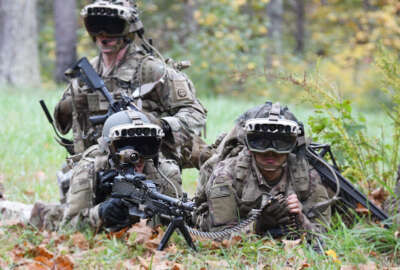Could telework be hindering Army’s civilian workforce development?
Agnes Gereben Schaefer, the Army’s assistant secretary for manpower and reserve affairs, said the service branch must improve how it markets and informs the...
The Army is struggling to attract and retain its workforce and some of its leaders think telework could be part of the problem.
Several Army leaders at the Association of the U.S. Army’s 2023 conference said that they must fix civilian recruitment challenges and leverage items that help improve recruitment efforts to bring the service branch into the future. They agreed that culture is vital to the Army’s recruitment efforts, particularly for the civilian workforce. However, telework can be a challenge to fostering the Army’s culture because of the lack of face-to-face contact in a remote environment.
Lt. Gen. Christopher Mohan, deputy commanding general and chief of staff for the Army Materiel Command, said the service must return to office like the private sector.
“We have got to relook at our current telework strategies, our current telework environment that we have created,” Mohan said. “We made a big deal about telework and we followed the commercial industry into telework and we need to follow them back out of it.”
However, telework is not the only challenge. According to the panelists, increasing the public’s awareness of what people can do as a civilian worker for the Army is critical to attracting more people to its workforce. One way is through marketing.
“One crucial aspect of strengthening innovation in our workforce is telling the Army story,” Agnes Gereben Schaefer, the Army’s assistant secretary for manpower and reserve affairs, said. “We must do a better job of promoting civilian jobs. We know we have a knowledge gap with the public. People still don’t know that we have lots of opportunities for civilian careers in the Army. We’re working hard to change that. I, for one, have never seen a commercial for an Army civilian and that breaks my heart. We’re going to change that.”
The Army also must inform the public about the impact of its civilian workforce and the work people can do as civilians working for the service. Lt. Gen. Maria Gervais, deputy commanding general and chief of staff, Army Training and Doctrine Command, said there is a unique opportunity for the Army to increase its civilian workforce by recruiting those who wanted to serve in uniform but were unable to.
“We have so many that want to come in and serve, but they may not because either medical, some other reason,” Gervais said. “Why aren’t we at that point going, ‘here is the opportunity for you to serve (in) a little bit (of a) different way.’”
The time it takes to hire can also hinder the Army’s workforce.
Karen Pane, director of human resources for the Army Corps of Engineers, said that it currently takes 35 days to hire someone under the corps’ direct hire authority, but she would like to make it one day. Meanwhile, Gervais and Mohan said that it takes them much longer than 35 days to hire because of hiring systems and processes, which they urged to be addressed.
“We’ve lost people in 35 days and I do not want to lose anybody…because we were too slow, and 35 days for the best engineer is just way too slow,” Pane said.
Echoing Pane’s point, Mohan said, “I agree, 35 days is too long; 100 days, who can go without a paycheck for 100 days? We have to acknowledge that.”
They agreed that USAjobs can be confusing. Mohan said that he has a pilot program to reduce the length of resumes to five pages. He added that they have offered on the spot or beta on the spot hiring and are working to shorten the length of hiring for their direct hire authority. Pane said that the Army Corps of Engineers has its own portal for jobs with three modules, that is purportedly easier to navigate than USAjobs. One module is on career events, which lets them see how many people at one point in time have been seen.
There are other measures that are important to boost the civilian workforce, such as increased flexibility, a workforce attitude change, talent management and expanding internships. The panelists agreed the Army must leverage peoples’ talents, hire the right people for the right roles to help the service fulfill its mission.
Meanwhile, Gervais said that the Army needs to look at recruiting differently and should already be thinking about how to reach Generation A—those born in the early 2010s. Furthermore, the panelists asserted that the Army must define what skills are needed for its civilian workforce. All stated the importance of digital and data skills.
The panelists agreed that the Army needs to define civilian readiness and should offer similar career development opportunities to those in uniform. For example, by offering courses and trainings when people reach certain levels.
The leaders stated the civilian workforce is important to the Army and it should show the impact civilians make by serving those who serve.
Copyright © 2025 Federal News Network. All rights reserved. This website is not intended for users located within the European Economic Area.
Kirsten Errick covers the Defense Department for Federal News Network. She previously reported on federal technology for Nextgov on topics ranging from space to the federal tech workforce. She has a Master’s in Journalism from Georgetown University and a B.A. in Communication from Villanova University.
Follow @kerrickWFED





